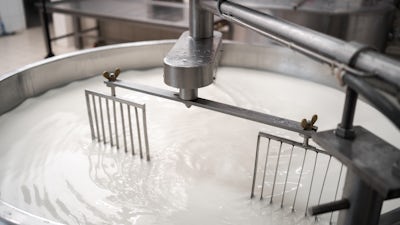6 Common Mixing Processes Explained
- Share on Facebook
- Share on LinkedIn
- Share on Email
-
Copy Link
-
Share Link
- Pharmaceutical
- February 1, 2018
- 7 Minute Read
- Share on Facebook
- Share on LinkedIn
- Share on Email
-
Copy Link
-
Share Link

Introduction
On a hot summer day, a glass of perfectly chilled lemonade hits the spot.
In an industrial pharmaceutical facility, a senior operator monitors precision mixing to ensure everything blends as it should. Success in both cases brings satisfaction, though the techniques are worlds apart.
The connection? Whether you're mixing lemonade or pharmaceuticals, the right approach makes all the difference. Each application demands a unique mix of agitation levels, shear, suspension, dispersion, pumping capacity, and more—tailored to achieve the desired outcome.
Read on to explore six common industrial mixing processes that can guide your equipment selection.
1. Blending Miscible Liquids
Miscibility refers to the ability of liquids to completely dissolve into one another, forming a stable, uniform solution. Unlike other mixtures, miscible liquids blend seamlessly without separating. A familiar example is the combination of carbonated water and orange juice to make orange soda.
Some manufacturers use only sweeteners and carbonated water, which must also be fully miscible to achieve the desired product quality. Blending miscible liquids typically does not require high-shear or intensive mixing techniques, as these liquids are inherently compatible at the molecular level.
The natural flow within the vessel is often sufficient for thorough mixing. Products that blend miscible liquids include injectables, ophthalmic solutions, and mouthwash, among many others. Depending on the specific formulation and process requirements, light to moderate agitation is generally adequate for optimal blending.
2. Soluble Solid-Liquid Dissolution
This process is frequently used in your kitchen at home. Have you ever poured a Kool-Aid® packet into a pitcher of water?
Mixing these two types of materials requires less aggressive agitation because miscible liquids are easy to blend. The amount of agitation required for solid-liquid dissolution depends on the solubility of the solid in the liquid.
Because of the differing material states, soluble solid-liquid dissolution often takes longer than blending two miscible liquids together. Flow-driven mixing is likely the best process for dissolving a powder into a liquid.
3. Chemical Reaction Facilitation
Chemical reactions can be much easier to achieve in small batches. However, the inefficiency of certain mixing techniques that are adequate for small batches can translate into poor results when the process is scaled up.
The Handbook of Industrial Mixing emphasizes the importance of avoiding channeling, bypassing, and dead zones" to prevent "poor reactor design and performance.
Flow is still the primary driver of reactions in many cases, but to ensure proper mixing and reactions throughout the entire batch, you should use at least moderate agitation.
Heating or pressurization of the formulation may cause a chemical reaction. Depending on the specific needs of the end product, any of these other mixing processes can be paired with a chemical reaction.
4. Insoluble Material Suspension Into Liquids
Products such as paint are created using a suspension of insoluble materials. Because pigments/dyes are often insoluble with other paint components, such as solvents like water, suspension can require a combination of flow- and shear-driven mixing.
According to the UNC Eshelman School of Pharmacy, suspensions are more chemically stable than solutions, although they sacrifice physical stability.
Suspended materials are more likely to settle, even when proper mixing techniques are used. The stability of the suspension depends on the components being used and how well they are mixed.
Products made with this process often require stirring or shaking before use. Insoluble material suspension is also used to make vitamin formulations, nutraceuticals (e.g., protein bars), and other viscous solutions in personal care products such as lotions and shampoos.
Again, the specific application will determine the specific mixing parameters, but suspension of insoluble materials will likely require moderate to aggressive agitation with shear.
5. Dispersing Solids Into Liquids
What is dispersion? Think about your blender at home; the little blades don't mix liquids very well, but when you need to blend some fruit to make a smoothie, it is the perfect tool for the job. Dispersion works by having high shear near the blades of the mixer.
Many mixing factors must be considered when your product requires solids dispersion in liquids. Will you use a batch, semi-batch, or continuous process? Is the solid likely to agglomerate and prevent necessary dispersion?
In many solid-liquid dispersion applications, the solid settles or agglomerates when the agitator speed slows down. It is important to know beforehand if the specific elements of your product will re-disperse when agitation is resumed.
Solids can settle on the bottom of the vessel if the agitator speed is too low, but sometimes, this is a useful feature of the mixing operation.
It all depends on how you want the end product to turn out. In most cases, aggressive, high-shear dispersion is the way to go.
6. Emulsifying Immiscible Liquids
Emulsification is an extremely common industrial process because it makes mixing formerly immiscible liquids possible.
Egg yolks contain lecithin, a natural emulsifier used in industrial food applications and in your kitchen. It has many useful applications in the food industry, such as milk, mayonnaise, and ice cream.
Even though emulsifiers are used in this process, more aggressive agitation techniques, such as using a high-shear impeller, are still necessary in many cases.
More from Mueller Academy
- Introducing Our New Membrane-Based Water for Injection (WFI) Skids
- Manway Gasket Installation & Bushing Adjustment
- How to Decide Between a Horizontal & Vertical Milk Tank
- MES & PSG Feedwater Quality Requirements
- On-Site Tank Fabrication Under Deadline
- Finding the Right Finish: Understanding Polishing
- Increase the Capacity of Your Clean Utility Equipment
- Balancing a Mueller Multiple Effect Still (MES)
- The Different Types of Steam in Industrial Steam Generation